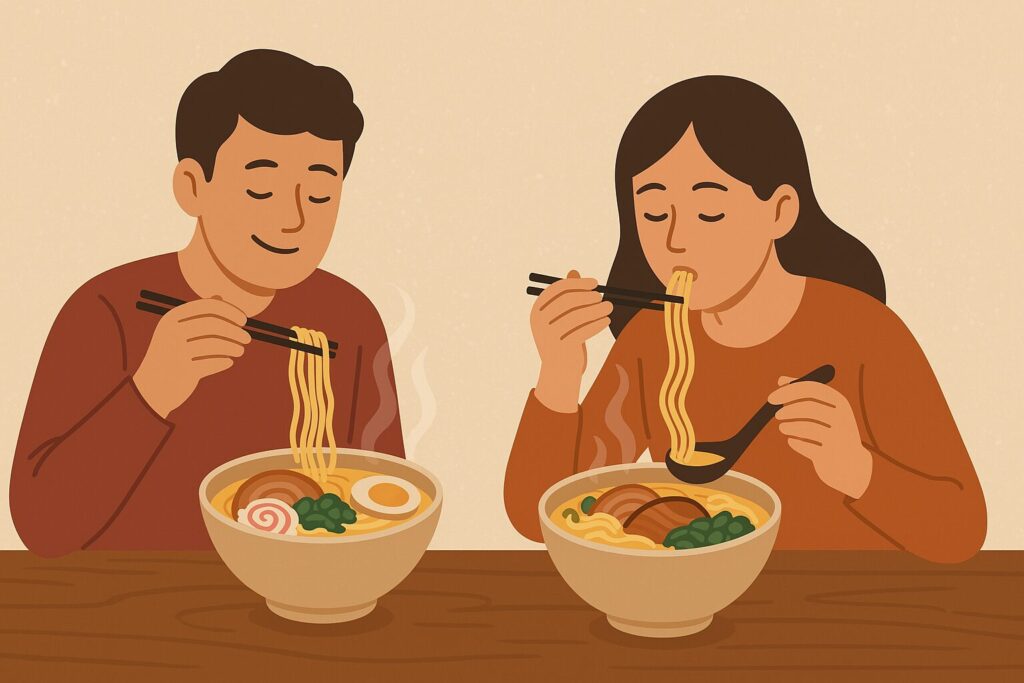ラーメンを英語で説明・紹介するための基本情報と、英会話に役立つ表現をシンプルでわかりやすい英語で紹介します。
英会話ダイアローグ・概要・10の質問を通して、ラーメンに関する英語表現を学びます。
英語
英会話ダイアローグを読む前に知っておくと良い前提知識と情報です。
- ラーメンの基本
- ラーメンは中国がルーツの麺料理だが、日本で独自の発展を遂げた
- 主な構成は、スープ、麺、トッピングの3つ
- ラーメンの基本的な種類
- 醤油ラーメン: 醤油ベースのタレを使った、最もポピュラーなラーメン
- 塩ラーメン: 塩ベースのタレを使った、あっさりとした味わいのラーメン
- 味噌ラーメン: 味噌ベースのタレを使った、濃厚でコクのあるラーメン
- とんこつラーメン: 豚の骨を長時間煮込んだ白濁したスープが特徴の、濃厚でクリーミーなラーメン
- 代表的なご当地ラーメン
- 博多ラーメン(福岡):細麺、豚骨スープが特徴
- 札幌ラーメン(北海道):中太ちぢれ麺、味噌スープ、バターやコーンのトッピングが特徴
- 喜多方ラーメン(福島):平打ち太麺、醤油ベースのあっさりスープが特徴
- ラーメンの人気の理由
- 手頃な値段で早く食べられる
- 種類が豊富で、飽きずに楽しめる
- 地域ごとに個性があり、日本各地で楽しめる
- 最近のラーメン事情
- 海外でも人気があり、「RAMEN」として世界で知られている
- ベジタリアン・ヴィーガン向けのラーメンも増えてきている
- トマトやチーズなどを使った創作系のフュージョンラーメンもある
2人がラーメンについて話しています。
ラーメンの魅力、主な特徴、地域ごとのラーメン、ベジタリアン向け、世界的な人気などを話題にしています。
会話 / dialogue

Hey Key, I just realized something—I’ve become kind of obsessed with ramen since I came to Japan.

Really? That’s great to hear! Ramen is a big part of Japanese food culture.

Yeah, every bowl I try is so different. The flavors are deep, and the noodles are perfect.

That’s one of the amazing things about ramen. It looks simple, but there’s a lot going on in one bowl.

I tried tonkotsu ramen in Fukuoka last month. The soup was so rich and creamy.

Hakata-style, right? That’s pork bone broth, boiled for hours. Very popular down there.

And just last week, I had miso ramen in Sapporo. It had corn and butter on top—so unique.

Yeah, Sapporo is known for that style. The cold weather probably inspired that rich miso flavor.

How many types of ramen are there? I feel like I’ve barely scratched the surface.

There are four main soup types—shoyu, shio, miso, and tonkotsu. But every region has its own version.

So it’s kind of like each area of Japan tells its own story through ramen?

Exactly. For example, Kitakata ramen has thick, flat noodles and a light soy sauce broth.

I love that every bowl is different. It makes eating ramen feel like an adventure.

Totally. And ramen shops compete by creating new styles or adding unique toppings.

I saw one that used tomato and cheese. It was almost like pasta, but still ramen.

That’s fusion ramen! It shows how ramen can keep evolving.

Is ramen popular with locals too, or just tourists like me?

Oh, it’s hugely popular. There are over 20,000 ramen shops in Japan.

Wow. I guess people never get tired of it.

Nope. It’s affordable, quick, delicious, and comforting. That’s the magic of ramen.

I’m also curious about vegetarian ramen. My friend doesn’t eat meat.

It’s becoming more common! Some places use vegetable broth, mushrooms, or soy-based toppings.

That’s good to know. I’ll try one next time. Maybe I’ll bring my friend too.

You should! There’s a famous vegan ramen shop at Tokyo Station—T’s Tantan.

Oh, I want to check that out. Honestly, I’m planning to do a “ramen tour” across Japan.

That sounds amazing. Each bowl is like tasting a different region.

Exactly! Ramen isn’t just food—it’s an experience I want to keep exploring.
概要(ラーメンの種類・特徴・魅力がわかる基本解説)
「ラーメン」について、理解を深めるための「英語での概要」です。
ラーメン

What is Ramen?
Ramen is a popular Japanese noodle dish. It originally came from China but has become very famous in Japan. Today, ramen is a special part of Japanese food culture. Many people around the world also love ramen.
Main Types of Ramen Soup
There are four main types of ramen soup. The first type is called shoyu ramen, which is a soy sauce-based soup. The second type is shio ramen, a salty and clear soup. The third type, miso ramen, uses fermented soybean paste and has a rich, deep flavor. The last main type is tonkotsu ramen, a creamy soup made from pork bones cooked for many hours.
Noodles and Toppings
Ramen noodles are usually made from wheat flour, water, and a special ingredient called “kansui,” which makes the noodles chewy. Noodles can be thin or thick, and straight or wavy. Common ramen toppings include sliced pork (called chashu), eggs, bamboo shoots (menma), green onions, and seaweed. These toppings add more flavor and texture to ramen.
Local Styles of Ramen
Japan has many regional styles of ramen. For example, Hakata ramen from Fukuoka is famous for its thin noodles and creamy pork broth. Sapporo ramen from Hokkaido uses miso soup with butter and corn. Kitakata ramen from Fukushima features thick noodles with a light soy sauce soup.
Popularity and Appeal
Ramen is popular because it is tasty, affordable, and easy to find. People enjoy discovering new ramen shops or making their own ramen at home. Recently, vegetarian ramen is becoming more common, using vegetable-based soups. Ramen continues to change and grow, which makes it an exciting dish for many people worldwide.
10の質問(ラーメンの種類と魅力がわかる基本Q&A)
「ラーメン」について、理解を深めるための「英語での10の質問」です。
1: What is ramen?
Ramen is a Japanese noodle dish with soup, noodles, and various toppings. It originally came from China but became a unique part of Japanese food culture.
2: What are the main types of ramen soup?
The four main types are shoyu (soy sauce), shio (salt), miso (fermented soybean paste), and tonkotsu (pork bone broth).
3: What are ramen noodles made of?
Ramen noodles are usually made of wheat flour, water, salt, and a special ingredient called kansui, which makes the noodles chewy.
4: What toppings are common in ramen?
Common toppings include sliced pork (chashu), boiled eggs, green onions, bamboo shoots, and seaweed.
5: What is special about tonkotsu ramen?
Tonkotsu ramen has a creamy, rich soup made by boiling pork bones for many hours. It is very popular in Fukuoka.
6: What is miso ramen known for?
Miso ramen has a strong and deep flavor. It is often served with corn and butter, especially in Sapporo, Hokkaido.
7: Are there regional types of ramen in Japan?
Yes, many regions have their own style. For example, Hakata ramen has thin noodles, and Kitakata ramen uses thick, flat noodles.
8: Why is ramen so popular in Japan?
Ramen is tasty, quick to eat, and not expensive. There are many styles, so people never get bored.
9: Is vegetarian ramen available?
Yes, some shops offer vegetarian ramen with vegetable-based soup and plant-based toppings.
10: Is ramen popular outside Japan?
Yes, ramen is now loved around the world. Many countries have ramen restaurants, and the word “ramen” is widely known.

和訳付
会話 / dialogue

Hey Key, I just realized something—I’ve become kind of obsessed with ramen since I came to Japan.
キー、ちょっと気づいたことがあるんだ。日本に来てから、俺ラーメンにハマっちゃったみたい。

Really? That’s great to hear! Ramen is a big part of Japanese food culture.
ホント?それはよかった!ラーメンは日本の食文化の代表みたいなものだからね。

Yeah, every bowl I try is so different. The flavors are deep, and the noodles are perfect.
そうなんだよ、食べるラーメンが毎回違ってさ。味が深いし、麺も完璧だし。

That’s one of the amazing things about ramen. It looks simple, but there’s a lot going on in one bowl.
それがラーメンのすごいところなんだよ。一見シンプルなのに、一杯の中にいろんな工夫が詰まってる。

I tried tonkotsu ramen in Fukuoka last month. The soup was so rich and creamy.
先月、福岡で豚骨ラーメンを食べたんだ。スープがすごく濃厚でクリーミーだったよ。

Hakata-style, right? That’s pork bone broth, boiled for hours. Very popular down there.
博多ラーメンでしょ?豚骨を何時間も煮込んだスープだよね。あの辺じゃ定番だよ。

And just last week, I had miso ramen in Sapporo. It had corn and butter on top—so unique.
それに先週は札幌で味噌ラーメンも食べたんだ。コーンとバターがのってて、すごくユニークだった。

Yeah, Sapporo is known for that style. The cold weather probably inspired that rich miso flavor.
ああ、札幌はそれが有名だね。寒い気候が、あの濃厚な味噌ラーメンを生んだのかもね。

How many types of ramen are there? I feel like I’ve barely scratched the surface.
ラーメンって何種類くらいあるの?まだまだ入り口に立ったばかりの気がするよ。

There are four main soup types—shoyu, shio, miso, and tonkotsu. But every region has its own version.
主なスープの種類だけで醤油、塩、味噌、豚骨の4種類。でも地域ごとに独自のラーメンがあるんだよ。

So it’s kind of like each area of Japan tells its own story through ramen?
つまり、日本各地がラーメンを通して自分たちのストーリーを伝えている感じかな?

Exactly. For example, Kitakata ramen has thick, flat noodles and a light soy sauce broth.
まさにその通り。例えば喜多方ラーメンは、平打ちの太麺にあっさりした醤油スープが特徴なんだ。

I love that every bowl is different. It makes eating ramen feel like an adventure.
一杯ごとに個性があるのが好きだな。ラーメンを食べるのが冒険みたいに感じる。

Totally. And ramen shops compete by creating new styles or adding unique toppings.
ホントだよね。ラーメン店は新しいスタイルや独特のトッピングを作って競い合ってるしね。

I saw one that used tomato and cheese. It was almost like pasta, but still ramen.
トマトとチーズを使ったラーメンも見たことがあるよ。まるでパスタみたいだったけど、ちゃんとラーメンだった。

That’s fusion ramen! It shows how ramen can keep evolving.
それはフュージョンラーメンだね!ラーメンがいかに進化を続けているかってことだよ。

Is ramen popular with locals too, or just tourists like me?
ラーメンって観光客だけじゃなく、地元の人にも人気あるの?

Oh, it’s hugely popular. There are over 20,000 ramen shops in Japan.
もちろん、すごく人気だよ。日本にはラーメン店が2万軒以上あるくらいだからね。

Wow. I guess people never get tired of it.
すごいな。みんな全然飽きないんだね。

Nope. It’s affordable, quick, delicious, and comforting. That’s the magic of ramen.
うん。安くて早くて美味しくてほっとする、それがラーメンの魅力なんだよ。

I’m also curious about vegetarian ramen. My friend doesn’t eat meat.
ベジタリアン向けのラーメンも気になるんだよね。友達が肉を食べないから。

It’s becoming more common! Some places use vegetable broth, mushrooms, or soy-based toppings.
最近増えてきてるよ!野菜出汁やキノコ、大豆を使ったトッピングの店もあるよ。

That’s good to know. I’ll try one next time. Maybe I’ll bring my friend too.
それはいい情報だな。次はそれを食べてみるよ。友達も連れて行こうかな。

You should! There’s a famous vegan ramen shop at Tokyo Station—T’s Tantan.
ぜひ!東京駅に有名なヴィーガンラーメンのお店「T’sたんたん」があるよ。

Oh, I want to check that out. Honestly, I’m planning to do a “ramen tour” across Japan.
お、それチェックしてみたいな。実は今、日本全国のラーメン巡りを計画してるんだ。

That sounds amazing. Each bowl is like tasting a different region.
それ最高だね。一杯ごとにその地域を味わえるみたいな感じだもんね。

Exactly! Ramen isn’t just food—it’s an experience I want to keep exploring.
そうなんだよね!ラーメンってただの食べ物じゃなくて、これからも探求していきたい「体験」なんだよ。
概要 (ラーメンの種類・特徴・魅力がわかる基本解説)
ラーメン

What is Ramen?
Ramen is a popular Japanese noodle dish. It originally came from China but has become very famous in Japan. Today, ramen is a special part of Japanese food culture. Many people around the world also love ramen.
ラーメンとは?
ラーメンは日本で人気の麺料理です。もともとは中国から伝わりましたが、日本でとても有名になりました。現在ではラーメンは日本の食文化の特別な一部となり、世界中でも愛されています。
Main Types of Ramen Soup
There are four main types of ramen soup. The first type is called shoyu ramen, which is a soy sauce-based soup. The second type is shio ramen, a salty and clear soup. The third type, miso ramen, uses fermented soybean paste and has a rich, deep flavor. The last main type is tonkotsu ramen, a creamy soup made from pork bones cooked for many hours.
ラーメンスープの主な種類
ラーメンスープには主に4つのタイプがあります。1つ目は醤油ラーメンで、醤油ベースのスープです。2つ目は塩ラーメンで、塩味のあっさりとした透明なスープです。3つ目の味噌ラーメンは発酵した大豆のペーストを使い、濃厚で深い味わいがあります。最後の豚骨ラーメンは、豚の骨を長時間煮込んだクリーミーなスープです。
Noodles and Toppings
Ramen noodles are usually made from wheat flour, water, and a special ingredient called “kansui,” which makes the noodles chewy. Noodles can be thin or thick, and straight or wavy. Common ramen toppings include sliced pork (called chashu), eggs, bamboo shoots (menma), green onions, and seaweed. These toppings add more flavor and texture to ramen.
麺とトッピング
ラーメンの麺は通常、小麦粉、水、そして「かん水」という特別な材料から作られます。このかん水が麺にコシを与えます。麺の太さは細麺や太麺があり、形もストレートかちぢれ麺などがあります。一般的なトッピングには、チャーシュー(豚肉のスライス)、卵、メンマ(竹の子)、ネギ、海苔などがあり、ラーメンにさらなる味と食感を加えます。
Local Styles of Ramen
Japan has many regional styles of ramen. For example, Hakata ramen from Fukuoka is famous for its thin noodles and creamy pork broth. Sapporo ramen from Hokkaido uses miso soup with butter and corn. Kitakata ramen from Fukushima features thick noodles with a light soy sauce soup.
地域ごとのラーメンのスタイル
日本には多くのご当地ラーメンがあります。例えば福岡の博多ラーメンは、細麺とクリーミーな豚骨スープで有名です。北海道の札幌ラーメンは味噌スープをベースにしていて、バターやコーンが使われます。福島県の喜多方ラーメンは、あっさりした醤油スープに太麺を使うのが特徴です。
Popularity and Appeal
Ramen is popular because it is tasty, affordable, and easy to find. People enjoy discovering new ramen shops or making their own ramen at home. Recently, vegetarian ramen is becoming more common, using vegetable-based soups. Ramen continues to change and grow, which makes it an exciting dish for many people worldwide.
人気と魅力
ラーメンは美味しくて手頃な価格であり、どこでも簡単に見つかるため人気があります。人々は新しいラーメン店を探したり、自宅で作ったりして楽しみます。最近では野菜ベースのスープを使ったベジタリアン向けのラーメンも増えてきています。ラーメンは常に進化を続けているため、世界中の多くの人にとって魅力的な料理となっています。
10の質問(ラーメンの種類と魅力がわかる基本Q&A)
1: What is ramen?
ラーメンとは何ですか?
Ramen is a Japanese noodle dish with soup, noodles, and various toppings. It originally came from China but became a unique part of Japanese food culture.
ラーメンはスープ、麺、さまざまなトッピングからなる日本の麺料理です。もともとは中国から来ましたが、日本で独自の食文化として発展しました。
2: What are the main types of ramen soup?
ラーメンの主なスープの種類は何ですか?
The four main types are shoyu (soy sauce), shio (salt), miso (fermented soybean paste), and tonkotsu (pork bone broth).
主なスープの種類は、醤油、塩、味噌、豚骨の4つです。
3: What are ramen noodles made of?
ラーメンの麺は何で作られていますか?
Ramen noodles are usually made of wheat flour, water, salt, and a special ingredient called kansui, which makes the noodles chewy.
ラーメンの麺は通常、小麦粉、水、塩、そして麺にコシを出す特別な材料「かん水」で作られています。
4: What toppings are common in ramen?
ラーメンによく使われるトッピングは何ですか?
Common toppings include sliced pork (chashu), boiled eggs, green onions, bamboo shoots, and seaweed.
よくあるトッピングには、チャーシュー(豚肉のスライス)、ゆで卵、ネギ、メンマ(竹の子)、海苔などがあります。
5: What is special about tonkotsu ramen?
豚骨ラーメンの特徴は何ですか?
Tonkotsu ramen has a creamy, rich soup made by boiling pork bones for many hours. It is very popular in Fukuoka.
豚骨ラーメンは、豚の骨を何時間も煮込んで作る、クリーミーで濃厚なスープが特徴です。福岡でとても人気があります。
6: What is miso ramen known for?
味噌ラーメンは何で知られていますか?
Miso ramen has a strong and deep flavor. It is often served with corn and butter, especially in Sapporo, Hokkaido.
味噌ラーメンは濃くて深い味わいが特徴です。特に北海道の札幌では、コーンやバターをのせて提供されることが多いです。
7: Are there regional types of ramen in Japan?
日本には地域ごとのラーメンがありますか?
Yes, many regions have their own style. For example, Hakata ramen has thin noodles, and Kitakata ramen uses thick, flat noodles.
はい、多くの地域に独自のラーメンスタイルがあります。たとえば、博多ラーメンは細麺、喜多方ラーメンは太くて平たい麺を使います。
8: Why is ramen so popular in Japan?
なぜラーメンは日本でそんなに人気があるのですか?
Ramen is tasty, quick to eat, and not expensive. There are many styles, so people never get bored.
ラーメンはおいしくて、すぐに食べられて、値段も手頃です。種類も豊富なので、飽きずに楽しめます。
9: Is vegetarian ramen available?
ベジタリアン向けのラーメンはありますか?
Yes, some shops offer vegetarian ramen with vegetable-based soup and plant-based toppings.
はい、野菜ベースのスープや植物性のトッピングを使ったベジタリアンラーメンを提供する店もあります。
10: Is ramen popular outside Japan?
ラーメンは日本以外でも人気ですか?
Yes, ramen is now loved around the world. Many countries have ramen restaurants, and the word “ramen” is widely known.
はい、ラーメンは今や世界中で愛されています。多くの国にラーメン店があり、「ラーメン」という言葉も広く知られています。

words & phrases
英会話ダイアローグと関連情報に出てきた単語・フレーズです(例文は各3つ)。

obsessed : 形容詞
意味: 何かにとりつかれたように夢中になっていること。/ Unable to stop thinking about something; very interested in or worried about something.
(日本でラーメンにハマっているマックが、自分の気持ちを「obsessed」と表現)
例文:
- He is obsessed with Japanese anime.
「彼は日本のアニメに夢中です。」 - I became obsessed with ramen after my trip to Tokyo.
「東京旅行のあと、ラーメンにハマりました。」 - She is obsessed with taking photos of her food.
「彼女は料理の写真を撮ることに夢中です。」
flavor : 名詞
意味: 食べ物や飲み物の味や風味。/ The taste of food or drink.
(ラーメンの「deep flavors(深い味わい)」という表現で登場)
例文:
- This soup has a rich flavor.
「このスープは濃厚な味がします。」 - I love the spicy flavor of this ramen.
「このラーメンのピリ辛風味が大好きです。」 - Each region has its own ramen flavor.
「各地域には独自のラーメンの味があります。」
broth : 名詞
意味: 肉・魚・野菜などを煮込んで作る薄いスープ。/ A clear soup made by boiling meat, fish, or vegetables.
例文:
- Tonkotsu ramen has a thick pork bone broth.
「豚骨ラーメンは濃厚な豚骨スープが特徴です。」 - The chicken broth smells delicious.
「チキンスープの香りがとても良いです。」 - Add some vegetables to the broth for more flavor.
「スープに野菜を加えるとさらに風味が増します。」
fusion : 名詞
意味: 異なるものの融合、特に異文化の料理の組み合わせ。/ A combination of different things, especially different types of food or culture.
(ラーメンにトマトやチーズを加えた「fusion ramen」として登場)
例文:
- I tried a Japanese-Italian fusion ramen with tomato sauce.
「トマトソースを使った和風イタリアンラーメンを食べました。」 - Fusion food is popular in many big cities.
「フュージョン料理は多くの大都市で人気です。」 - That restaurant is famous for Asian-Mexican fusion dishes.
「あのレストランはアジアとメキシコ料理の融合で有名です。」
comforting : 形容詞
意味: 心を落ち着かせる、安心させる、癒してくれるような。/ Making you feel less sad or worried; providing comfort.
(ラーメンの魅力の一つとして「comforting(ほっとする)」が挙げられている)
例文:
- Hot ramen is very comforting on a cold day.
「寒い日には熱々のラーメンがとても癒されます。」 - Her words were very comforting to me.
「彼女の言葉にとても救われました。」 - This soft music is so comforting.
「この穏やかな音楽はとても心地よいです。」
